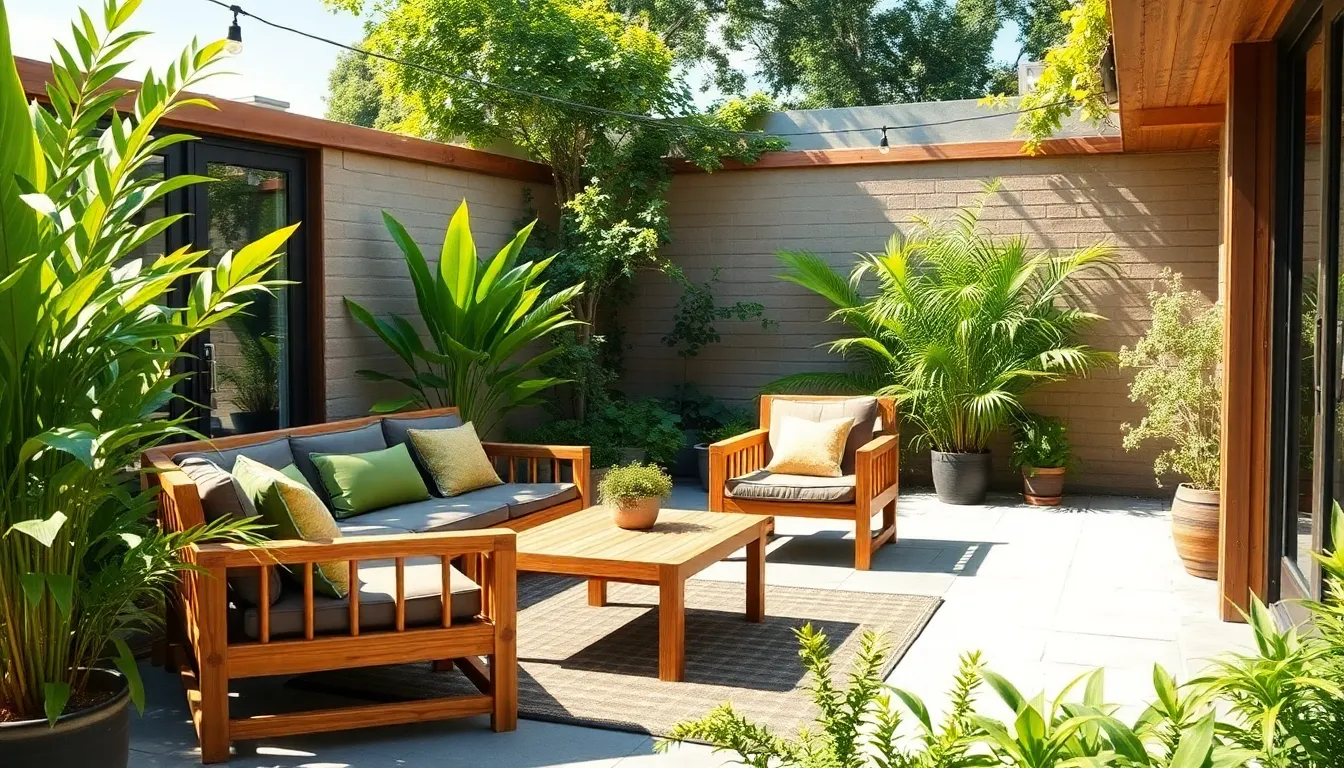Imagine lounging in your backyard, sipping iced tea, and feeling good about your choices. Sustainable outdoor furniture makes that dream a reality. It’s not just about style; it’s about saving the planet while you soak up the sun. Who knew being eco-friendly could look so chic?
Sustainable Outdoor Furniture?
Sustainable outdoor furniture refers to pieces designed with eco-friendly materials and manufacturing processes. This type of furniture often incorporates recycled or renewable materials, significantly reducing negative environmental impacts. Common materials include reclaimed wood, bamboo, and recycled metals, ensuring durability while promoting a lower carbon footprint.
Style remains uncompromised in sustainable outdoor furniture, as designs range from classic to modern aesthetics that appeal to diverse preferences. Many manufacturers prioritize eco-design principles, creating functional yet stylish options for patios, decks, and gardens. This approach not only enhances outdoor spaces but also fosters greater awareness of environmental responsibility.
Certifications such as Forest Stewardship Council (FSC) and Global Recycle Standard (GRS) verify the sustainability claims of furniture brands. These standards help consumers identify truly eco-friendly products in a market that often misrepresents sustainability. Selecting certified options ensures that purchases contribute positively to forest conservation and waste reduction initiatives.
Production processes for sustainable outdoor furniture emphasize energy efficiency and waste minimization. Companies often utilize renewable energy sources for manufacturing, further supporting green initiatives. By choosing sustainable outdoor furniture, individuals support the transition toward a more responsible and eco-conscious lifestyle.
Sustainable outdoor furniture proves beneficial for both the environment and personal well-being. Investing in these pieces fosters a connection to nature, encouraging outdoor living while making responsible choices. As awareness of ecological issues grows, so does the appeal of sustainable options that ensure quality, durability, and visual appeal in outdoor settings.
Benefits of Sustainable Outdoor Furniture

Sustainable outdoor furniture provides numerous advantages for both individuals and the environment. Eco-friendly choices encompass a range of benefits, from reducing carbon footprints to promoting healthier living.
Environmental Impact
Sustainable outdoor furniture significantly reduces the negative impact on ecosystems. Selecting products made from reclaimed wood, bamboo, or recycled metals encourages resource conservation and waste reduction. Utilizing certifications such as Forest Stewardship Council or Global Recycle Standard ensures responsible sourcing. Choosing furniture produced with renewable energy lowers dependence on fossil fuels. Such initiatives contribute to reduced greenhouse gas emissions. As consumers prioritize eco-friendly options, demand for sustainable products rises, promoting better environmental practices throughout the industry.
Health Benefits
Health benefits arise from using sustainable outdoor furniture. Many eco-friendly materials do not release harmful chemicals. This leads to safer environments for relaxation and recreation. Breathable fabrics and natural finishes promote better air quality. Outdoor spaces furnished with sustainable pieces foster a stronger connection to nature. Additionally, those using these products support healthier ecosystems, which in turn enhance wellbeing. Prioritizing sustainability often translates to improved mental health, thanks to inviting outdoor settings that encourage rest and rejuvenation.
Types of Sustainable Outdoor Furniture
Sustainable outdoor furniture comes in various forms, each catering to different tastes and preferences while ensuring environmental responsibility. Understanding the materials and design considerations enhances the selection process for eco-conscious consumers.
Materials Used
Reclaimed wood stands out as a popular choice for outdoor furniture, offering durability and a unique aesthetic. Bamboo also deserves mention; its fast-growing nature makes it a renewable resource with a stylish appeal. Recycled metals provide robustness and can be molded into intricate designs. Other options include recycled plastics, which resist fading and weathering. Natural fibers, like cotton or jute, contribute soft textures through cushions and rugs. Each material encourages environmental responsibility and aligns with the sustainable furniture mission.
Design Considerations
Design plays a vital role in sustainable outdoor furniture, merging aesthetics with functionality. Multi-functional pieces optimize space, making them ideal for smaller patios or gardens. Ergonomic designs ensure comfort and usability, enhancing overall outdoor experiences. Color trends shift toward earthy tones, which blend seamlessly with outdoor environments. Modular designs offer adaptability, allowing for rearrangement as needed. Choosing durable designs reduces the frequency of replacements, further supporting sustainability efforts. Each consideration meticulously balances style, comfort, and eco-friendliness.
How to Choose Sustainable Outdoor Furniture
Selecting sustainable outdoor furniture involves identifying key features and recognizing brands committed to eco-friendly practices.
Key Features to Look For
Look for furniture made from eco-friendly materials like reclaimed wood, bamboo, or recycled metals. Choose designs certified by organizations such as the Forest Stewardship Council or Global Recycle Standard. Prioritize durability to minimize replacements, ensuring the product withstands various weather conditions. Check for products that use non-toxic finishes and breathable fabrics, which promote safety and improve air quality. Consider multi-functional designs that maximize space while serving various purposes, enhancing functionality in outdoor areas.
Brands Committed to Sustainability
Seek brands known for their commitment to sustainable practices. Companies like Brown Jordan and Polywood focus on creating durable furniture from recycled materials. Design Within Reach offers stylish options made from responsibly sourced resources. Others, like Fermob, prioritize eco-conscious production methods while maintaining aesthetic appeal. Researching brand certifications can uncover leaders in sustainability, giving consumers confidence in their purchasing decisions. These brands often share their sustainability practices online, providing transparency about their commitment to environmental responsibility.
Conclusion
Choosing sustainable outdoor furniture is a meaningful way to enhance outdoor spaces while prioritizing the health of the planet. By selecting pieces made from eco-friendly materials and supporting brands committed to sustainability, individuals can create beautiful and functional environments. These choices not only reflect personal style but also contribute to a healthier ecosystem.
As the demand for sustainable options grows, consumers play a crucial role in shaping industry practices. Embracing sustainable furniture fosters a deeper connection to nature and encourages healthier living. Ultimately, investing in sustainable outdoor furniture is a step toward a more eco-conscious lifestyle that benefits both people and the environment.

